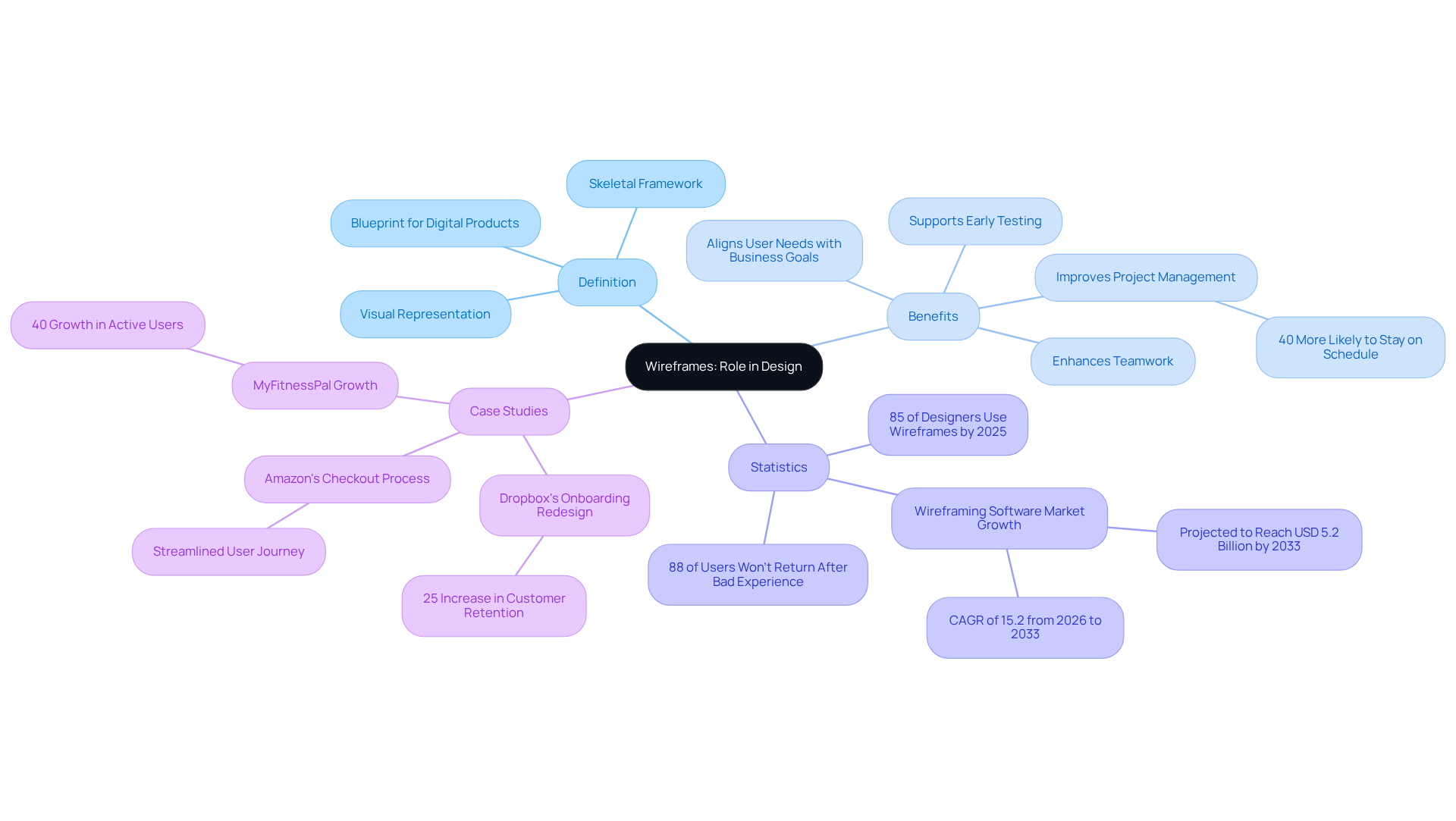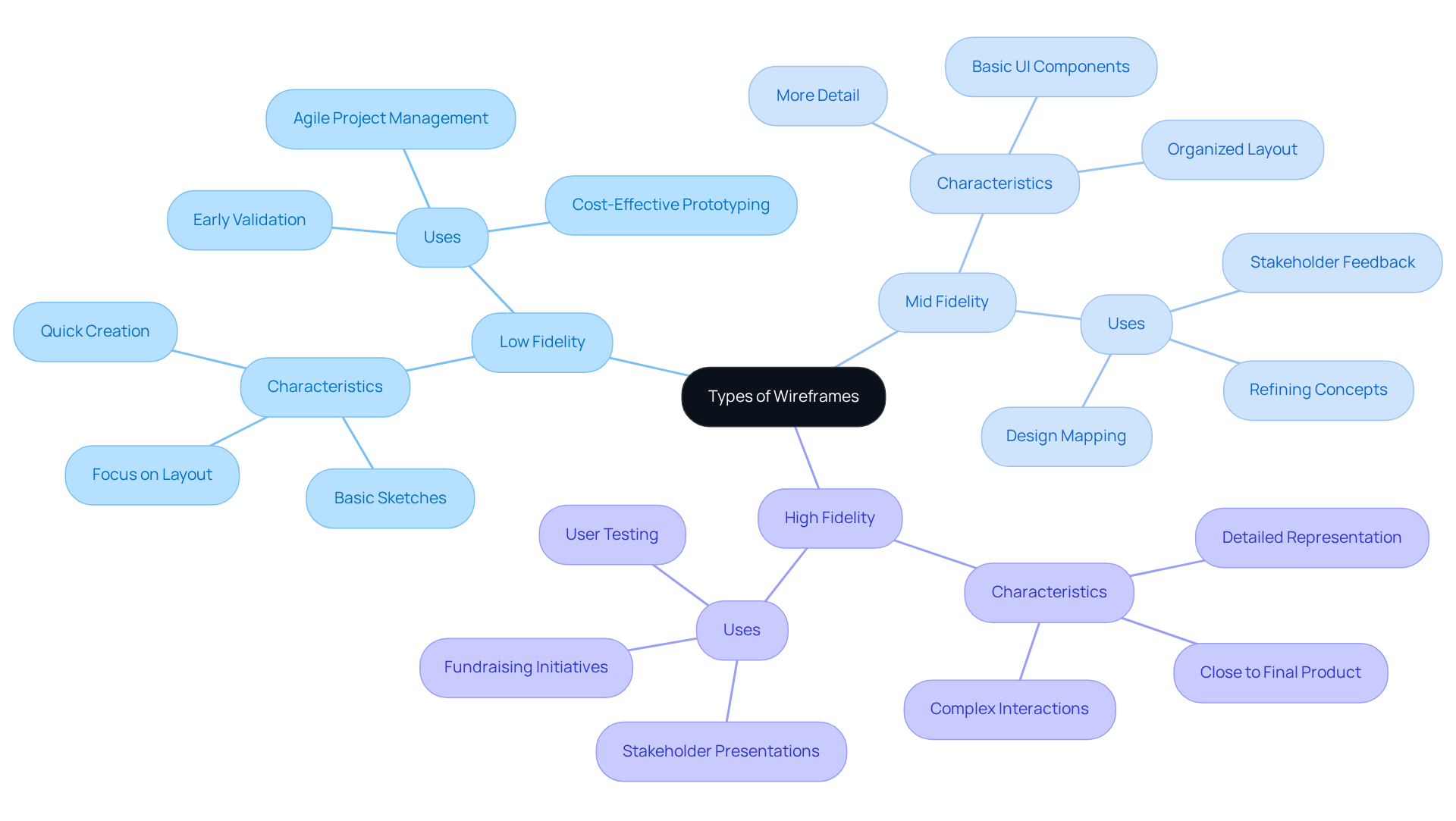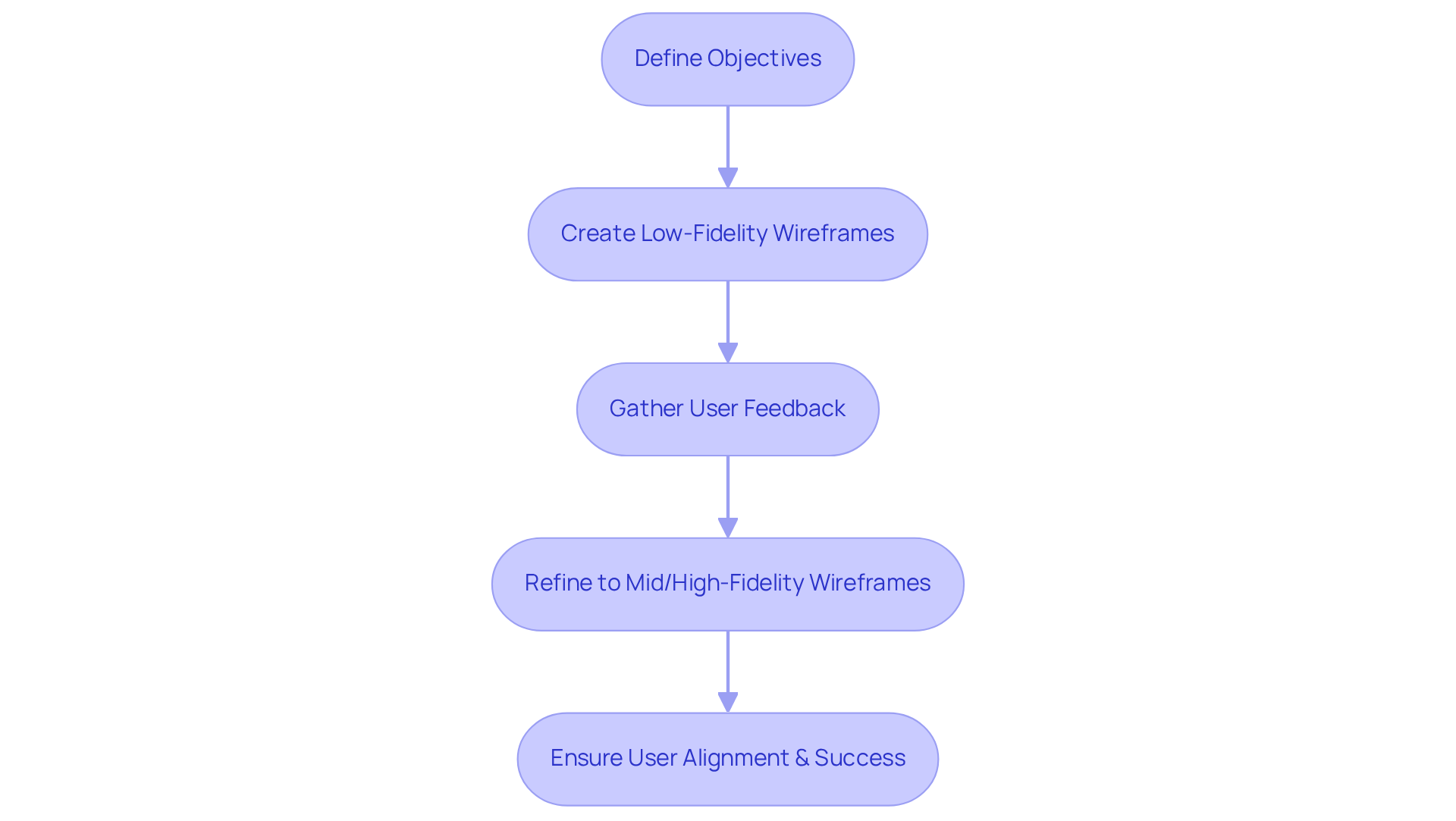Overview
In the fast-paced world of digital product design, many founders face the challenge of ensuring that their vision aligns with user needs and business goals. This misalignment can lead to frustration and setbacks, impacting both the team and the end users. Wireframes emerge as essential visual tools, acting as blueprints that not only outline the structure and functionality of digital products but also foster collaboration among designers and stakeholders. By visualizing interactions early in the process, wireframes help identify potential design issues before they escalate, nurturing a smoother workflow.
The importance of wireframes cannot be overstated. They serve as a bridge between technical requirements and user experience, enhancing the overall journey for everyone involved. Projects that utilize wireframes are statistically more likely to stay on schedule and achieve better outcomes, which is a comforting thought for any tech startup founder. Imagine the relief of knowing that a structured approach can lead to a more efficient process and a product that truly resonates with users.
At RNO1, we understand the emotional weight of these challenges. We believe in the power of wireframes to not only clarify design intentions but also to instill confidence in the development process. By embracing this tool, you can create a space where ideas flourish, and user needs are prioritized, ultimately leading to a successful product launch. Let’s work together to harness the potential of wireframes, ensuring that your vision comes to life in the most effective way possible.
Introduction
In the fast-paced world of digital design, wireframes often represent the backbone of your projects, serving as a clear visual guide to a product's structure and functionality. Yet, they are much more than mere sketches; they are strategic tools that help designers and stakeholders come together to understand user needs and business goals right from the start.
As the digital landscape continues to evolve, many teams face the challenge of effectively leveraging wireframes to enhance user experience and streamline workflows. This can feel daunting, but it’s a common struggle that many tech startup founders encounter.
In this article, we will explore the vital role of wireframes in design, discussing their various types, benefits, and best practices for implementation. Together, we will uncover how embracing wireframes can transform the way products are created and experienced, ultimately fostering a more collaborative and effective design process.
Define Wireframes: Understanding Their Role in Design
What are wireframes? They are essential visual representations that outline the skeletal framework of digital products, such as websites and applications. To understand what are wireframes, they serve as blueprints that demonstrate the layout, structure, and functionality of the interface without delving into specifics like colors or graphics. By focusing on the arrangement of elements, wireframes empower designers and stakeholders to envision interactions, ensuring that needs and business objectives are effectively aligned. This crucial phase in the creation process not only encourages teamwork but also promotes meaningful discussions about user experience (UX) before moving on to more intricate development tasks.
At RNO1, we understand that every interaction matters deeply. This belief makes wireframing a vital part of our creative-focused approach. By emphasizing design layouts, we enhance the alignment of user needs with business goals, ultimately driving digital growth for tech startups. In 2025, a significant percentage of designers—approximately 85%—will incorporate wireframes into their workflows, underscoring their importance in the design process. Projects that utilize design mockups are 40% more likely to stay on schedule, showcasing their effectiveness in project management. Experts agree that what are wireframes is not merely a formality; they are an essential element that facilitates early testing and feedback, ultimately enhancing the overall experience.
Consider the successful applications of layout designs seen in notable case studies, like Dropbox's onboarding overhaul, which led to a remarkable 25% rise in customer retention. This illustrates how prototypes can clarify experiences and simplify interactions, aligning client needs with business objectives. Furthermore, 88% of users are less likely to revisit a site after a negative experience, highlighting the critical role of efficient design in creating . Additionally, with 67% of companies viewing UX as a crucial competitive differentiator, the role of prototypes in promoting user-centered approaches becomes even more significant. The wireframing software market is projected to grow at a CAGR of 15.2% from 2026 to 2033, reflecting the increasing importance of wireframing in the industry. By prioritizing user-focused layouts through mockups, brands can significantly enhance their digital presence and foster sustainable growth.

Contextualize Wireframes: Importance in the Design Process
What are wireframes? They are essential in the creation process, acting as a visual blueprint that outlines the structure and functionality of a digital product. When we prioritize usability and user flow, we ensure that the final product is intuitive and aligns with user expectations. Introducing initial layouts early in a project allows teams to identify potential design problems, enabling necessary modifications before committing significant time and resources to intricate design and development. This proactive approach not only saves time but also fosters collaboration among team members, as visual prototypes serve as a common reference point for discussions and feedback.
Consider the experience of Expedia, which found that wireframing led to remarkable improvements in conversion rates by facilitating quick iterations based on user feedback. Similarly, MyFitnessPal experienced a 40% increase in active users after leveraging design layouts to enhance user engagement. Moreover, conducting usability assessments on mockups can uncover potential issues early in the development process, as illustrated in the case study 'Highlighting Usability Issues Before Full Prototyping.' These examples underscore how mockups help in identifying structural issues early, ultimately leading to more favorable outcomes and a smoother development cycle. By incorporating what are wireframes into the development workflow, we can enhance clarity, streamline communication, and ensure that all stakeholders are aligned with the project’s vision. As Vlad Gavriluk wisely remarked, "Good creation is like a refrigerator—when it works, no one notices, but when it doesn't, it stinks." This serves as a poignant reminder of the , particularly regarding mockups. Furthermore, utilizing wireframing tools such as Figma and Adobe XD can provide valuable resources for teams eager to learn what are wireframes and implement effective wireframing in their projects.

Explore Types of Wireframes: Low, Mid, and High Fidelity
In the world of UI/UX design, understanding what are wireframes is essential, as they are tools that can make a significant difference for tech startup founders. Many face the challenge of translating their innovative ideas into tangible designs, and this is where what are wireframes comes into play. They are categorized into three main types based on fidelity: low, mid, and high.
- Low-fidelity prototypes act as basic sketches, prioritizing layout and structure. They are often created quickly, allowing for brainstorming sessions that help teams confirm concepts early on. This early validation can significantly decrease the chances of expensive shifts later in the development process.
Imagine a tech startup using low-fidelity prototypes to clarify their vision and uncover potential pitfalls. This proactive approach not only fosters a more efficient design workflow but can also save tens of thousands of dollars by avoiding major app revisions post-launch. For instance, a basic mobile app prototype might be built for as little as $5,000 using lean UX principles, showcasing the financial advantages of this approach.
- As we move up the fidelity scale, mid-fidelity wireframes build on this foundation by incorporating more detail, such as text and . This level of fidelity offers a clearer depiction of interactions, which is vital for communicating concepts and gathering feedback from stakeholders. It’s an organized approach that can ease the stress of creating concepts after initial brainstorming sessions, allowing teams to feel more confident in their direction.
- High-fidelity prototypes, on the other hand, closely resemble the final product. They showcase intricate elements and interactions, making them crucial for user testing and stakeholder presentations. Picture a startup using high-quality prototypes to enhance their fundraising initiatives by providing potential investors with a concrete depiction of their product. This not only showcases feasibility but also elevates the aesthetic standard, instilling confidence in both the team and their investors.
Understanding what are wireframes is crucial, as each type serves a distinct purpose in the creation process, allowing teams to iterate and enhance their ideas effectively. Understanding the distinctions between is crucial for improving the creation process and ensuring successful project outcomes. Moreover, having a solid grasp of UX terms is essential for effective communication among team members, fostering collaboration and project success.
Low-fidelity prototypes, in particular, empower clients to assess whether to add or eliminate features in an interface without the burden of intricate designs. They demonstrate adaptability and usefulness in the design process, reinforcing the idea that even the simplest sketches can lead to profound insights and decisions. By embracing this approach, tech startup founders can navigate their design challenges with confidence and clarity.

Implement Wireframes: Best Practices and Tools for Creation
Creating can often feel overwhelming for designers, especially when the stakes are high. It's crucial to define clear objectives for each wireframe, as knowing what are wireframes helps ensure alignment with user needs and project goals. Starting with low-fidelity wireframes helps illustrate what are wireframes, allowing for rapid iteration and feedback that can then be refined into mid or high-fidelity versions as the project evolves. Tools like Figma, Balsamiq, and Miro can simplify this process, fostering teamwork and enabling immediate updates.
Imagine how much easier it would be to maintain consistency in visual elements and utilize actual content placeholders. This approach can significantly enhance what are wireframes' effectiveness, making it easier for stakeholders to envision the final product. Remember, for every $1 invested in UX, you can expect a return of $100, highlighting the financial benefits of effective wireframing. The eCommerce industry, for instance, faces a staggering loss of approximately $1.420 trillion due to poor UX. These figures underscore the importance of prioritizing user experience in your designs.
Integrating user feedback during the development phase is essential. This iterative method not only promotes improved outcomes but also ensures that the voices of users are heard and valued. What are wireframes? They can serve as a shared reference point for teams, fostering alignment and collaboration throughout the design process. Together, we can navigate these challenges and create designs that resonate with users, ultimately leading to greater success.

Conclusion
Wireframes are not just tools; they are essential companions in the design journey, acting as visual blueprints that outline the structure and functionality of digital products. Many designers struggle to balance usability and user flow, which can lead to misunderstandings about user interactions. This can create a disconnect between designers and stakeholders, making it challenging to align objectives with user needs. However, embracing wireframes during this initial phase encourages collaboration and opens the door for meaningful discussions, ultimately enhancing the overall user experience.
In this article, we’ve explored various facets of wireframes, including their definition, types, and best practices for implementation. Each type—low, mid, and high-fidelity wireframes—plays a unique role in the design workflow, allowing teams to iterate and refine their ideas effectively. Real-world examples, such as the successes of Dropbox and Expedia, illustrate how wireframes can lead to improved user engagement and conversion rates. The financial benefits of investing in effective wireframing are clear, with significant returns linked to enhanced user experiences.
For tech startups and established companies alike, integrating wireframes as a core component of the design process is crucial. By welcoming user feedback and utilizing effective wireframing tools, teams can navigate design challenges with clarity and confidence. The importance of wireframes cannot be overstated; they are not merely a step in the design process but a vital foundation for crafting intuitive and engaging digital experiences that resonate deeply with users. Together, let’s embrace wireframes and cultivate designs that truly connect with our audience.
Frequently Asked Questions
What are wireframes?
Wireframes are essential visual representations that outline the skeletal framework of digital products, such as websites and applications. They serve as blueprints that demonstrate the layout, structure, and functionality of the interface without detailing specifics like colors or graphics.
What is the purpose of wireframes in the design process?
Wireframes help designers and stakeholders envision interactions, ensuring that user needs and business objectives are effectively aligned. They encourage teamwork and meaningful discussions about user experience (UX) before moving on to more intricate development tasks.
How do wireframes contribute to project management?
Projects that utilize design mockups are 40% more likely to stay on schedule, showcasing the effectiveness of wireframes in facilitating project management and enhancing workflow.
What percentage of designers are expected to incorporate wireframes into their workflows by 2025?
Approximately 85% of designers are expected to incorporate wireframes into their workflows by 2025, underscoring their importance in the design process.
Can you provide an example of the impact of wireframing on user experience?
An example is Dropbox's onboarding overhaul, which led to a 25% rise in customer retention. This illustrates how prototypes can clarify experiences and simplify interactions, aligning client needs with business objectives.
Why is user experience (UX) important for companies?
67% of companies view UX as a crucial competitive differentiator, highlighting the significance of user-centered approaches in promoting effective design.
What is the projected growth of the wireframing software market?
The wireframing software market is projected to grow at a CAGR of 15.2% from 2026 to 2033, reflecting the increasing importance of wireframing in the industry.
How do wireframes enhance digital growth for tech startups?
By prioritizing user-focused layouts through mockups, brands can significantly enhance their digital presence, foster sustainable growth, and align user needs with business goals.




